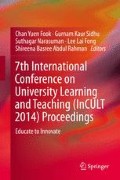Abstract
The current shift from the traditional mode of learning to student-centred learning has created an impact on the content development and the delivery methodology in the instruction-learning process. There is a strong push by the Malaysian Government to develop creativity, communications skills, analytical and critical thinking, and problem-solving skills – skills that were significantly lacking in current graduates. As such, the prevailing research issue is the challenge in finding the most suitable combination of content and technology to enable students to acquire these skills and experiences. The MILE Project (funded by TM R&D) was developed to address this issue. This paper presents a research study that was conducted in the Faculty of Creative Multimedia, Multimedia University, Malaysia, to investigate Malaysian students’ perceptions of using The MILE Project learning platform. Students engaged in problem-solving on design projects, collaborated on blogs and actively engaged in interactive multimedia content. Results showed that students displayed high levels of motivation and understanding, improved problem-solving skills and teamwork abilities, and were able to relate their acquired skills and experiences to the real-world. These results provided strong support for Malaysian educators to use pedagogically sound blended learning strategies in the classrooms to improve the teaching and learning process.
Access this chapter
Tax calculation will be finalised at checkout
Purchases are for personal use only
References
Alessi, S. M., & Trollip, S. R. (2001). Multimedia for learning: Methods and development (3rd ed.). Boston: Allyn & Bacon.
Al-Huneidi, A., & Schreurs, J. (2013). Constructivism based blended learning in higher education. In Information systems, e-learning, and knowledge management research (pp. 581–591). Berlin/Heidelberg: Springer.
Garcia, P. G. (2012). Collaborative learning activities in online courses: Issues and strategies. ASEAN Journal of Open Distance Learning, 4(1), 1–16.
Guan, Y. H. (2009). A study on the learning efficiency of multimedia-presented, computer-based science information. Educational Technology & Society, 12(1), 62–72.
Herrington, J., & Kervin, L. (2007). Authentic learning supported by technology: 10 suggestions and cases of integration in classrooms. Educational Media International, 44(3), 219–236.
Herrington, J., Reeves, T. C., & Oliver, R. (2010). A guide to authentic e-learning. New York: Routledge Publishing.
Herrington, J., Reeves, T. C., & Oliver, R. (2014). Authentic learning environments. New York: Springer.
Hillis, P. (2008). Authentic learning and multimedia in history education. Learning, Media and Technology, 33(2), 87–99.
Hong, K. S., Lai, K. W., & Holton, D. (2003). Students’ satisfaction and perceived learning with a web-based course. Educational Technology & Society, 1, 116–124.
Laurillard, D. M. (2008). The teacher as action researcher: Using technology to capture pedagogic form. Studies in Higher Education, 33(2), 139–154.
Mahajan, G. (2012). Multimedia in teacher education: Perceptions & uses. Journal of Education and Practice, 3(1), 5–12.
Malaysia Ministry of Education (MOE). (2008). National report: Education in Malaysia. Malaysia: Ministry of Education.
Malaysia Ministry of Education (MOE). (2012). National education policy. Malaysia: Ministry of Education.
McCarthy, J. (2010). Blended learning environments: Using social networking sites to enhance the first year experience. Australasian Journal of Educational Technology, 26(6), 729–740.
Muller, D. A., Lee, K., & Sharma, M. D. (2008). Coherence or interest: Which is most important in online multimedia learning? Australasian Journal of Educational Technology (AJET), 24(2), 211–221.
Neo, M. (2013). Enhancing the teaching and learning process with the MILE research lab. Invited book chapter. Pelan Strategik Pengajian Tinggi Negara (National Strategic Plan) – Selected activities series 4 (Ministry of Education Malaysia ), Malaysia, 4, 130–141.
Neo, T. K., & Neo, M. (2010). A study using web-logs or blogs as a tool for student-centred learning in a computer graphics course: A Malaysian perspective. The International Journal of Learning, 17(9), 77–86.
Neo, M., & Neo, T. K. (2013). Exploring students’ creativity and design skills through a multimedia project: A constructivist approach in a Malaysian classroom. Design and Technology Education: An International Journal, 18, 48–59.
Suh, H. (2011). Collaborative learning models and support technologies in the future classroom. International Journal for Educational Media and Technology, 5(1), 50–61.
Tan, O. S., Teo, C. T., & Chye, S. (2009). In Oon-Seng, T (Ed.), Problem-based learning and creativity (pp. 1–14). Singapore: Cengage Learning Asia Pte. Ltd.
Wilson, B. G. (1995). Metaphors for Instruction: Why we talk about learning environments. Educational Technology, 35(5), 25–30.
Acknowledgements
The authors would like to thank the Centre for Adaptive Multimedia Educational Learning cOntent Technologies (CAMELOT), The MILE Research Lab, TM Research and Development (TMR&D) for funding this project, the Faculty of Creative Multimedia, and students of Multimedia University for agreeing to participate in this study.
Author information
Authors and Affiliations
Corresponding author
Editor information
Editors and Affiliations
Rights and permissions
Copyright information
© 2016 Springer Science+Business Media Singapore
About this paper
Cite this paper
Mai, N., Yeen-Ju, H.T., Ludin, N. (2016). Enhancing Malaysian Students’ Learning with Interactive Multimedia and the Web: The MILE Project. In: Fook, C., Sidhu, G., Narasuman, S., Fong, L., Abdul Rahman, S. (eds) 7th International Conference on University Learning and Teaching (InCULT 2014) Proceedings. Springer, Singapore. https://doi.org/10.1007/978-981-287-664-5_29
Download citation
DOI: https://doi.org/10.1007/978-981-287-664-5_29
Publisher Name: Springer, Singapore
Print ISBN: 978-981-287-663-8
Online ISBN: 978-981-287-664-5
eBook Packages: EducationEducation (R0)

